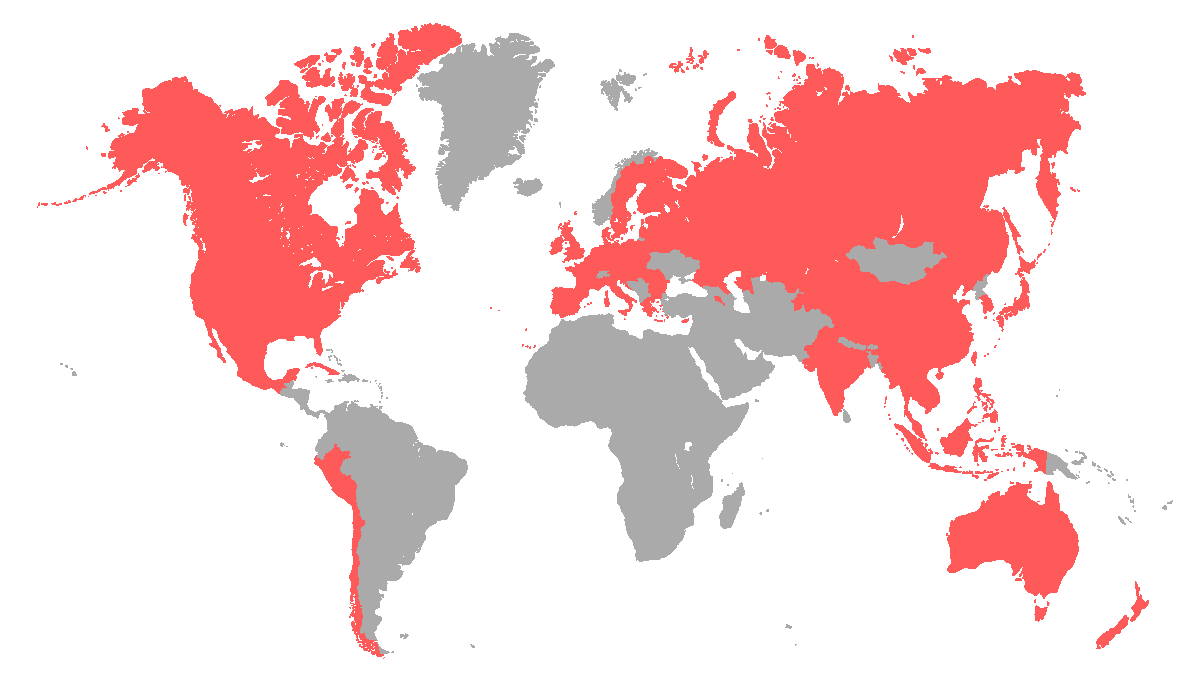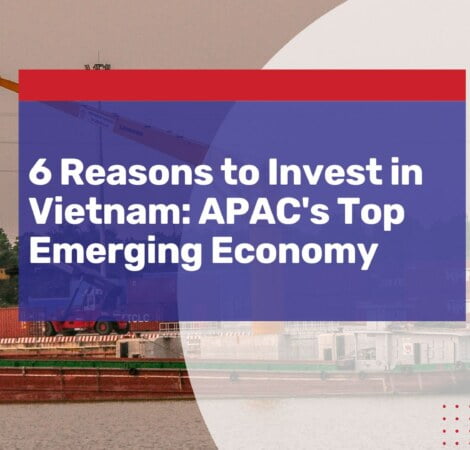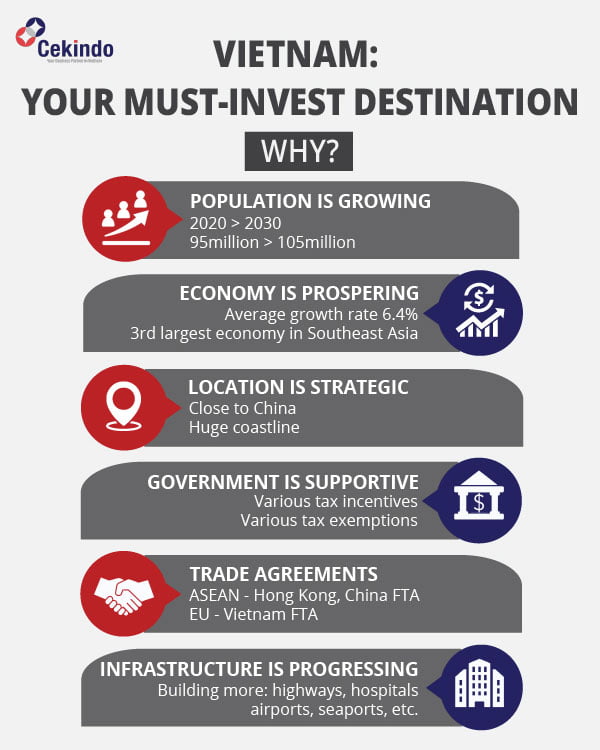Vietnam has made rapid development and the country’s economic performance is expected to overtake many Southeast Asian countries, including Thailand and Singapore. In fact, since the early 1990s, thanks to the strong inflow of foreign investments, Vietnam has seen GDP growth averaging over 6.3% each year, with 2022 recording the second most impressive growth at 8.02%.
Apart from the country’s beautiful sceneries and amazing beaches, what draws in all the interest of foreign investment is the lucrative business setup opportunities, abundant resources, inexpensive workforce, a strategic location in Asia-Pacific, and favorable business environment.
 1. A Young & Growing Population
1. A Young & Growing Population
Vietnam has a population of approx. 98 million people and 57% are active participants in the country’s labor force.
The majority of the workforce is employed across the 3 main economic sectors of the nation: manufacturing (16% of GDP), services (51%), and agriculture (14%). Vietnam’s unemployment rate was 2.19% in the first quarter of 2021. This remarkably young talent pool fuels the nation’s robust and steady economic growth.
The number of statutory working-age employed individuals was estimated at 45 million in Q2 2022, up 2.3% from the same period last year, according to data shared by the General Statistics Office.
With unemployment rates down 34.9% from Q1 2022 and the number of those negatively impacted by COVID-19 down 52.7%, Vietnam is showing strong signs of recovery from the pandemic.
2. A Stable & Prospering Economy
Vietnam’s economy is on track to achieve rapid growth in Southeast Asia. 2022 saw the fastest annual growth rate for Vietnam’s GDP since 1997 was achieved in 2022 at a historic growth rate of 8.02%, thanks to robust domestic retail sales and exports. However, in 2023, the economy is expected to feel the effects of the global slowdown.
As per the World Economic League Table 2022, published by the Centre for Economics and Business Research (CEBR), Vietnam’s economy will undergo rapid development to emerge as Southeast Asia’s second-largest economy after Indonesia by 2036. The country’s GDP per person in 2021 was USD 11,608 per capita (on the basis of purchasing power parity). The nation has achieved exceptional economic growth and has become a middle-class country by taking advantage of favorable global trends.
3. Supportive Government Policies
The government of Vietnam has come up with several attractive tax incentives as it promotes a more open economy to draw-in international investment. These incentives include investing in underdeveloped regions of the country, engaging in tech-based sectors, and deferring payment of taxes during the initial period of establishment in the nation.
4. Sustainable Growth Plans
Vietnam and many other nations have pledged to reduce hazardous fumes by striving to neutralize carbon footprints by 2050 to address the challenges posed by climate change. The significant investment made by the nation in alternative energy sources, particularly wind and solar, is a clear indication of this.
At the same time, Vietnam plans to reduce its reliance on coal by 2030 while increasing its installed capacity for wind and solar power generation by up to 38 gigawatts. Other measures undertaken by the Vietnamese government to further its carbon neutrality objectives include carbon pricing and Emission Trading Scheme (ETS).
According to Reuters, the government has contacted developed countries to let them know that to meet its ambitious renewable energy targets, it requires money, technology, and expertise from international investors.
5. Favorable Trade Agreements

1. EU-Vietnam Free Trade Agreement (EVFTA)
The EU-Vietnam Free Trade Agreement seeks to increase trade volumes, strengthen the labor market, and promote economic growth on both sides via:
- Elimination of almost 99% of all import taxes
- Taking measures to protect investor interests
- Removing bureaucracy and unnecessary red tape practices
- Reducing barriers to swift and easy trade
- Promoting public procurement markets and services
2. Comprehensive and Progressive Agreement for Trans-Pacific Partnership (CPTPP)
The Comprehensive and Progressive Agreement for Trans-Pacific Partnership represents one of the largest free-trade regions in the world, with 11 members and it came into effect on December 30, 2018.
As the terms of the agreement were enforced, existing tariffs on nearly 43% of the country’s garment exports to Canada were to be abolished immediately. Moreover, after four years, these taxes would be cut down by 100%. The agreement further emphasizes the importance of Vietnam’s labor reforms and the enhancement of the working environment. This agreement went into effect in Vietnam on 14th January 2019.
3. UK-Vietnam Free Trade Agreement (UKVFTA)
UKVFTA, which became effective on May 1, 2021, will entail the significant tariff eliminations.
For goods exported from the UK to Vietnam:
- 48.5% of tariff items were removed on January 1, 2021.
- 91.8% of duties are set to be removed by January 1, 2027.
- 98.3% of tariffs are set to be removed on January 1, 2029.
- 1.7% of the tariff lines are partly liberalized by tariff rate quotas or do not qualify for special treatment.
For goods imported from Vietnam to the UK:
- 85.6% of tariff items were removed on January 1, 2021.
- 99.2% are set to be removed by January 1, 2027.
- 0.8% of the tariff lines will be partly liberalized via tariff rate quotas
The agreement further focuses on the market liberalization of goods, investments, and services. In addition, there are commitments regarding labor welfare, social responsibility, and sustainable development.
4. The U.S.-Vietnam Bilateral Trade Agreement (BTA)
The U.S.-Vietnam Bilateral Trade Agreement (BTA) was put into place to encourage freedom in trade and development between the two nations. The agreement, which became officially applicable on December 10, 2001, also covers topics including product and service trade, investor security, intellectual property copyright compliance, and business incentives.
The tariff rates considerably decreased after Vietnam joined the World Trade Organization in the year 2007 and have further decreased since then.
5. ASEAN Free Trade Area
The ASEAN Free Trade Area, or AFTA, is acknowledged as among the world’s most important free trade regions. It was created to boost local commerce and production across all ASEAN nations.
The AFTA has inspired some of the largest trade blocs and forums worldwide. These include the Asia-Pacific Economic Cooperation and the East Asia Summit, along with the Regional Comprehensive Economic Partnership.
AFTA aims to clear all tariff and non-tariff obstacles to turn ASEAN into a powerful production hub on the global stage.
6. ASEAN – China Free Trade Agreement (ACFTA)
Leaders from ASEAN and China met in 2000 to discuss ways to promote greater economic cooperation between the two areas. As a result, the ASEAN-China Free Trade Area was established the following year and it was formally enforced on July 1, 2003.
The ASEAN-China Free Trade Area eventually grew to become the third-biggest FTA in terms of nominal GDP and the largest FTA in terms of people covered.
7. Australia – New Zealand – ASEAN Free Trade Agreement
The ASEAN – Australia and New Zealand Free Trade Agreement (AANZFTA) was established to foster new investment opportunities between ASEAN, Australia, and New Zealand. It is a comprehensive free trade agreement that, by implementing an open and accommodating investment framework, seeks to promote sustained economic growth between the two economic blocs. The agreement was set into force on January 1, 2010.
The AANZFTA discusses:
- At least 90% of all tariff lines to see a steady reduction or elimination of tariffs;
- Using modern, flexible rules of origin, quicker processes, and more transparent methods, enabling a frictionless flow of products;
- Removing trade restrictions will eventually open up new markets for the region’s service providers.
- Preserving investors’ interests
8. Vietnam – South Korea Free Trade Agreement (VKFTA)
The VKFTA states that South Korea will eliminate 95% of the tariff lines for Vietnam, while Vietnam will remove 90% of the tariff lines on goods imported from South Korea. The agreement also discusses how the two countries view environmental rules, intellectual property rights, and competition legislation.
After the agreement entered into effect, South Korea agreed to allow the import of 500 more items from Vietnam. In addition, the import duties on products including tropical fruits, shrimp, fish, crab, clothes and textiles, and forestry commodities were all set to be reduced.
9. Vietnam- Japan Economic Partnership Agreement (VJEPA)
The Vietnam-Japan Economic Partnership Agreement (VJEPA) was implemented on October 1, 2009, to support regional trade and enhance the business climate in the two countries. Vietnam will work to abolish 90.64% of the tariff lines in accordance with the agreement.
10. ASEAN – India Free Trade Area
In 2009, ASEAN and India signed the ASEAN-India Trade in Goods Agreement, which led to the establishment of one of the biggest FTAs in the history of the world. As long as the agreement is in force, both trading blocks will consent to supply under the conditions listed below:
- Over 90% of the goods exchanged between the two Asian countries will have lower tariffs.
- Removing taxes on more than 4,000 product categories.
11. Vietnam – Eurasian Free Trade Agreement (VN-EAEU FTA)
With the establishment of the Free Trade Agreement between the Eurasian Economic Union (EAEU- which comprises Russia, Armenia, Belarus, Kazakhstan, and Kyrgyzstan) and Vietnam, the country’s businesses now have access to a market of over 180 million new clients across Eurasia. The agreement was officially implemented on October 5, 2016.
12. Regional Comprehensive Economic Partnership (RCEP)
It covers around 30% of the global population and is recognized as the biggest FTA in the world. This historic trade deal was officially implemented on January 1, 2022
The trade deal makes it easier for member countries to reach the Chinese market, which is one of the largest consumer marketplaces in the world. Moreover, the RCEP is anticipated to have a significant positive impact on Vietnam’s agriculture sector.
13. Vietnam – Cuba Trade Agreement
As former communist allies, Vietnam and Cuba have long-standing ties. The Vietnam-Cuba Trade Agreement, which was signed in 2018, places emphasis on laws governing the rules of origin, trade in products, trade defense, and technical requirements. The agreement was formally set into force on April 1, 2020.
According to the agreement, both parties have begun the process of totally eliminating or significantly lowering duties on all goods imported from each other’s respective markets. To execute the trade agreement until 2027, the Vietnamese government recently issued Decree No. 114/2022/ND-CP on a list of Vietnam’s special favorable import tariffs.
14. Vietnam-Chile Free Trade Agreement (VCFTA)
The year 2011 saw the signing of the Free Trade Agreement between Vietnam and Chile under the APEC summit.
- Vietnam pledged to remove 87.8% of the tariffs, corresponding to 91.22% of Chile’s total import revenue in 2007. By the end of the plan in 2029, only 12.2% of tariff lines (mainly in sensitive industries like agriculture and fossil fuels) will be exempt from reductions.
- Chile now has greater access to Vietnamese exports: 83.54% of all tariff lines were removed immediately after the Agreement went into effect. The majority of the commodities from Vietnam (99,62%) will no longer be subject to tariffs in Chile by 2029.
6. Ideal Logistical Location and Progressing Infrastructure
Vietnam attracts foreign investors because of its proximity to prominent Asian cities and nations, particularly China. At the same time, the country is also situated quite close to many shipping routes for imports and exports because of its extensive coastline.
Vietnam is also witnessing rapid infrastructure development due to the country’s expanding economy. In recent years, the government has set aside a sizable fund to spend on the nation’s infrastructure, including new ports, international airports, hospitals, motorways, and more.
Transport and shipping inside Vietnam are also becoming easier and more effective thanks to improved infrastructure. Due to the Vietnamese government’s partnership with international corporations in developing the country’s modern infrastructure, foreign businesses have numerous investment prospects to explore.
About Us
InCorp Vietnam is a leading provider of global market entry services. We are part of InCorp group, a regional leader in corporate solutions, that encompasses 8 countries in Asia-Pacific, headquartered in Singapore. With over 1,100 legal experts serving over 15,000 Corporate Clients across the region, our expertise speaks for itself. We provide transparent legal consulting, setup, and advice based on local requirements to make your business perfectly fit into the market with healthy growth.
Don’t take our word for it. Read some reviews from some of our clients.

 1. A Young & Growing Population
1. A Young & Growing Population